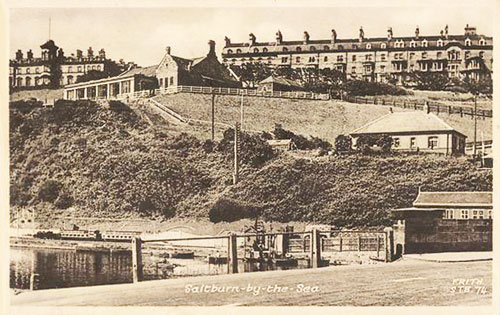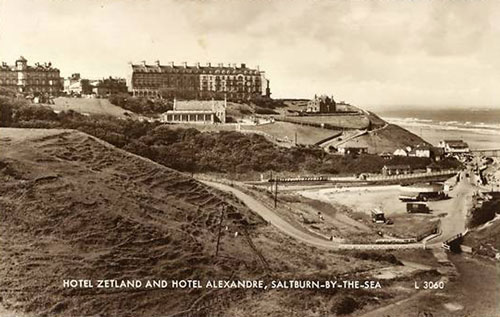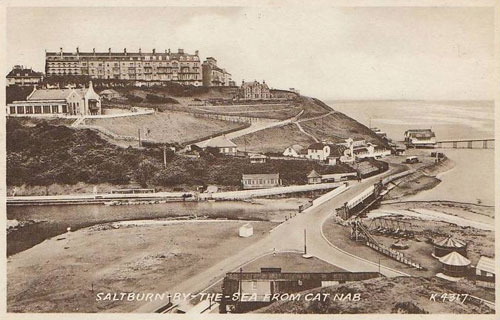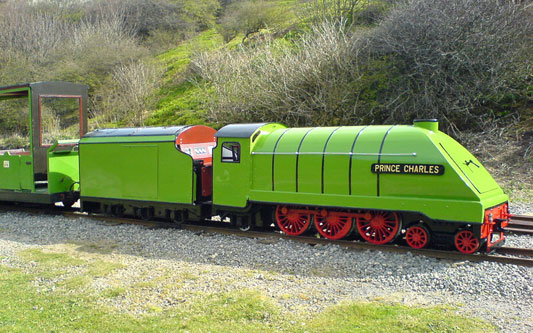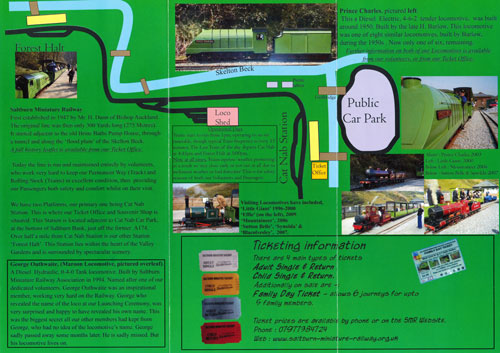|
|
|
| |
Pier - Cliff Lift - Miniature Railway
All images link to larger
copies which will open in a new window/tab
|
|
|
This page shows images of the pier, cliff lift, and
miniature railway at Saltburn by Sea.
|
|
|
|
|
|
Pier - Cliff Lift - Miniature Railway
All images link to larger
copies which will open in a new window/tab
Saltburn Pier
The Stockton and
Darlington Railway arrived in Saltburn from Redcar on August 17, 1861,
prompting a growth in day trippers and holiday travellers. The engineer
for the railway line was John Anderson, who saw the investment
opportunities in the new town, buying land from the Saltburn Improvement
Company. He bought plots in Milton and Amber Streets, as well as
Britannia Terrace/Marine Drive - both now Marine Parade - where he
designed and erected the Alexandria Hotel. Appointed resident engineer
of the SIC in 1867, he designed the town's sewerage system. In October
1867, Anderson formed the Saltburn Pier Company, to undertake
construction of a suitable pier. Contracted as designer and chief design
engineer, Anderson followed the new pier format developed by Eugenius
Birch in his ground breaking design for Margate Pier, by specifying iron
screw-piles to support a metal frame and wooden deck.
Deliveries of iron work from the
Ormesby Foundry began in December 1867, with the first pile drive
started by Mrs Thomas Vaughan of Gunnergate Hall on December 30. But
construction was delayed by the fact that the Board of Trade did not
grant an order for the construction until April 6, 1868, while the
foreshore land was not transferred to the company until July 3, 1868.
The 1,500 feet (460 m) pier opened in May 1869, with a steamer landing
stage at the head of the pier and two circular kiosks at the entrance.
The first steamers left the pier on May 14, 1870, with service to
Middlesbrough. In the first six months of operation, there were 50,000
toll-paying visitors. Access to the pier was difficult from the town via
the steep cliff, so Anderson was contracted to build the Cliff Hoist.
Constructed of wood, it allowed 20 people to be placed in a wooden cage
and then lowered by rope to beach level. It opened on July 1, 1870, some
14 months after the opening of the pier, it was approached from the town
by a narrow walkway. The passengers then descended 120 feet (37 m),
after water had been added to or taken away from a counterbalance tank
Steamer excursions added to the
companies revenue, with new seasonal trips to Hartlepool and
Scarborough. This financial success enabled the Pier Company to announce
profitable dividends for its shareholders, and by October 1873 it was
announced that all the shares had been disposed of. However, on the
night of 21/22 October 1875, a gale struck the pier, removing 300 feet
(91 m) of the structure at the seaward end, including the pier head,
landing stage and part of the pier deck. In the middle of an iron trade
slump, it was decided not to replace the missing section or reconstruct
a landing stage, leaving a redeveloped pier of 1,250 feet (380 m).
Reopened in 1877, the debts of the company led to it being sold in 1880
at auction at the Alexandra Hotel for £800. Sold initially to the
Saltburn Improvement Company, in August 1883 the SIC was bought by the
owners of the Middlesbrough Estate.
The new owners had the Cliff
Hoist inspected by independent engineers, who condemned it due to
numerous rotten timbers, so it was demolished in late 1883. They
commissioned Sir Richard Tangye's company, who had built the two earlier
vertically inclined water powered funicular railways in Scarborough, to
build a replacement. Tangye had appointed George Croydon Marks head of
the lift department, in which role he was in charge of the design and
installation at Saltburn. Marks designed and constructed the Saltburn
Cliff Lift, a funicular with a height of 120 feet (37 m) and a track
length of 207 feet (63 m), creating a 71% incline. Opened on Saturday
June 28, 1884, it remains today the worlds oldest water-balanced cliff
railway. The opening of the Cliff Lift allowed the pier company to
undertake a development of facilities. As had originally been intended,
a saloon was built at the pier head, while gas lighting was provided
along the entire length. In 1884, the pier head was widened and
windshields, a bandstand, a refreshment rooms added, and the entrance
kiosks replaced to match the style of those used on the new Cliff Lift.
In July 1887 the gas lighting was replaced by electricity.
After suffering slight storm
damage in 1900, the pier was struck by the china clay vessel SS Ovenbeg
(formerly the Russian registered SS St Nicholi), in May 1924. The
collision left a 210 feet (64 m) gap in the promenade, leaving the
bandstand inaccessible. The gap was replaced from March 1929, with a new
theatre also built on the landside, completed in 1930 enabling the full
length of the pier to open.
Purchased by the council in
1938, the pier like others was sectioned during World War II, by having
part of the deck removed by the Royal Engineers to guard against Nazi
invasion. But due to its poor post war condition, repairs were not
granted planning permission until 1949, and due to a shortage of steel
not completed until April 1952. Officially reopened for the first time
since the war on May 31, 1952, over 25,000 visitors walked the pier
during the first month. In 1953, gales resulted in £23,000 worth of
repairs, which took a further five years to complete. But after
completion, in 1958 tow piles were lost, costing a further £6,000. In
1961 another twenty piles were twisted in storms, but repairs kept the
structure open enabling 90,000 people to visit during the 1960s. After
severe storms in 1971 and 1973, piles were lost at the seaward end
leaving the pier in a dangerous state. Further damage in 1974 culminated
on October 29, when the pier head was lost and the deck damaged, leaving
a length of 1,100 feet (340 m).
In 1975 the council submitted an
application to the Department of the Environment to have the pier
demolished. A "Save the Pier" campaign led to a public enquiry, which
concluded that only the final thirteen piers could be removed. This left
a 681 feet (208 m) length of refurbished pier, which reopened on June
29, 1978. In 1979, the council undertook a complete refurbishment of
both the pier and the Cliff Lift to reflect the Victorian/Edwardian
character, by: ordering new aluminium cars for the Cliff Lift,
reinstating to the design stained-glass windows; new distinct white-red
cladding to all the structures; a pier head cafe. In 2000, the council
was successful in gaining a £1.2M National Lottery Heritage Grant,
enabling the cast iron trestles that support the pier to be conserved,
and the steel deck beams replaced with traditional hardwood timber to
reflect the pier’s original appearance. Reopened as a Grade II* listed
building on July 13, 2001, by MP Chris Smith, the restored structure won
a top placing in the Queen’s Golden Jubilee Heritage awards. In October
2005, the pier was greatly enhanced by the installation of under deck
lighting which illuminates at night,[1] and in 2009, the National Piers
Society awarded it pier of the year.
Ref: wikipedia.com
Postcard
of Saltburn Pier
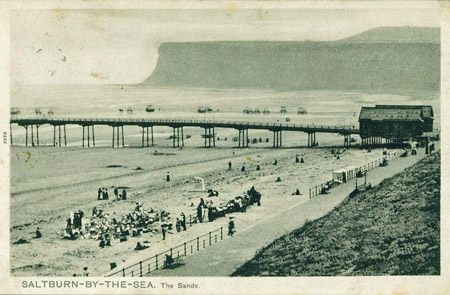
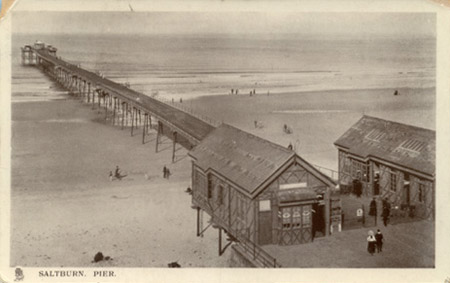
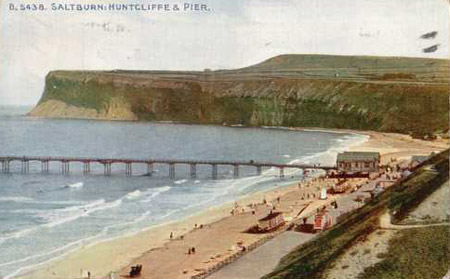
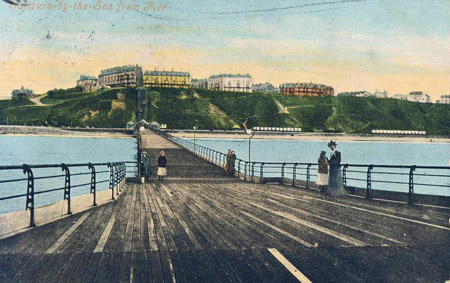
Postcard
of Saltburn Pier
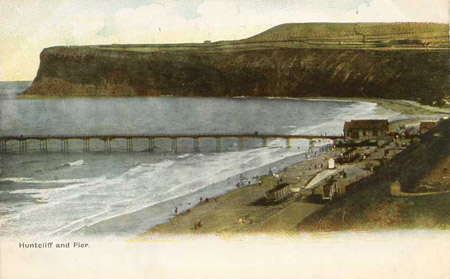
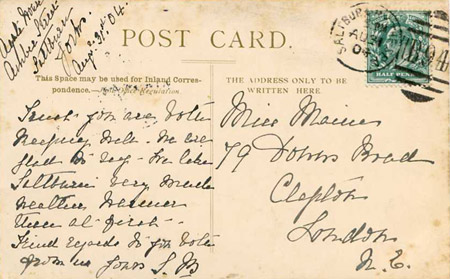
Postcard
of Saltburn Pier
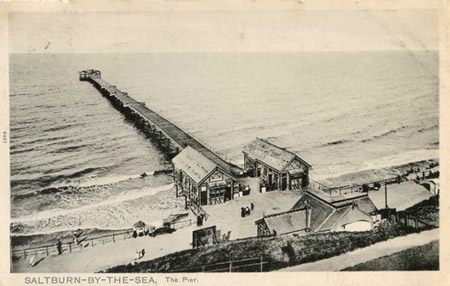
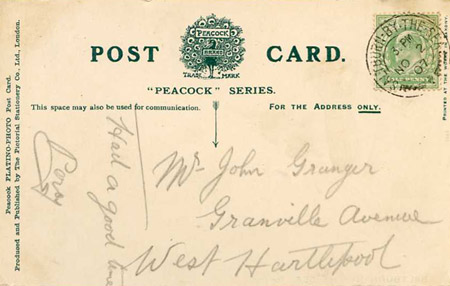
Saltburn Cliff Pier and view from the top of the
lift
Photo: ©2011 Dave Pennock
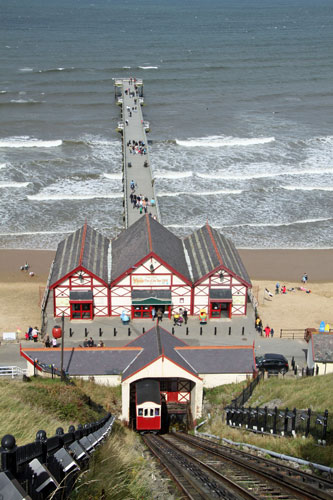
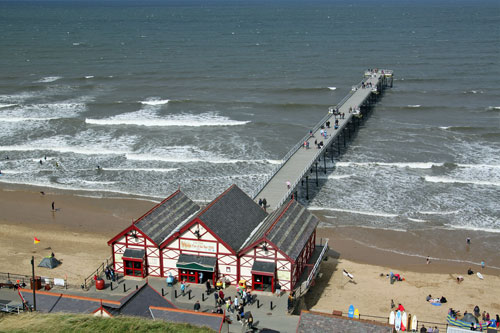
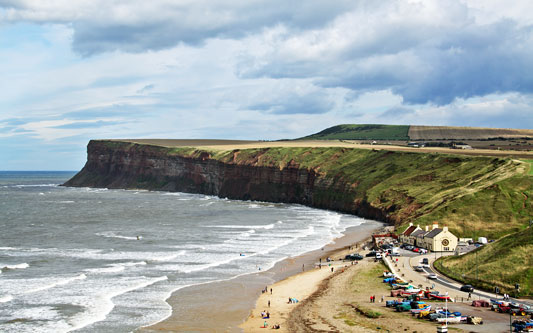
Access to the pier was difficult from the town via
the steep cliff, so Anderson was contracted to build the Cliff Hoist.
Constructed of wood, it allowed 20 people to be placed in a wooden cage
and then lowered by rope to beach level. It opened on July 1, 1870, some
14 months after the opening of the pier, it was approached from the town
by a narrow walkway. The passengers then descended 120 feet (37 m),
after water had been added to or taken away from a counterbalance tank.
However, on the
night of 21/22 October 1875, a gale struck the pier, removing 300 feet
(91 m) of the structure at the seaward end, including the pier head,
landing stage and part of the pier deck. In the middle of an iron trade
slump, it was decided not to replace the missing section or reconstruct
a landing stage, leaving a redeveloped pier of 1,250 feet (380 m).
Reopened in 1877, the debts of the company led to it being sold in 1880
at auction at the Alexandra Hotel for £800. Sold initially to the
Saltburn Improvement Company, in August 1883 the SIC was bought by the
owners of the Middlesbrough Estate. The new owners had the Cliff
Hoist inspected by independent engineers, who condemned it due to
numerous rotten timbers, so it was demolished in late 1883. They
commissioned Sir Richard Tangye's company, who had built the two earlier
vertically inclined water powered funicular railways in Scarborough, to
build a replacement. Tangye had appointed George Croydon Marks head of
the lift department, in which role he was in charge of the design and
installation at Saltburn. Marks designed and constructed the Saltburn
Cliff Lift, a funicular with a height of 120 feet (37 m) and a track
length of 207 feet (63 m), creating a 71% incline. Opened on Saturday
June 28, 1884, it remains today the worlds oldest water-balanced cliff
railway. The opening of the Cliff Lift allowed the pier company to
undertake a development of facilities. As had originally been intended,
a saloon was built at the pier head, while gas lighting was provided
along the entire length. In 1884, the pier head was widened and
windshields, a bandstand, a refreshment rooms added, and the entrance
kiosks replaced to match the style of those used on the new Cliff Lift.
In July 1887 the gas lighting was replaced by electricity.
Ref: wikipedia.com
Postcard
of Saltburn Pier and Cliff Lift, described as an Incline Tramway on the card
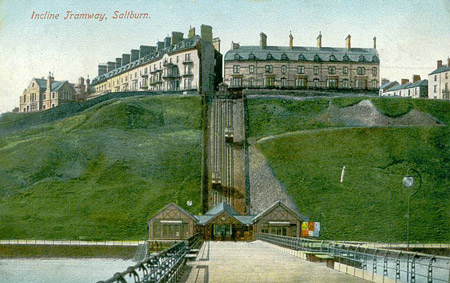
Postcard of the lower entrance to Saltburn Cliff
Lift
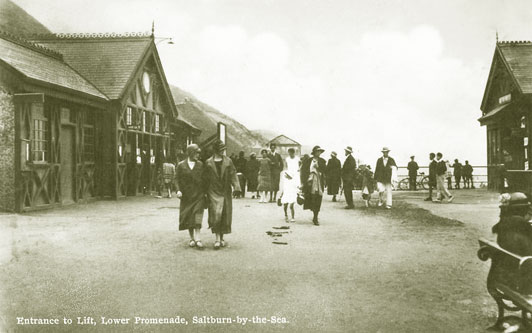
Saltburn Cliff Lift and Pier
Photo: ©2011 Dave Pennock

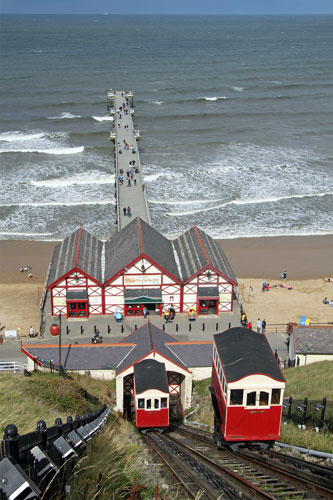
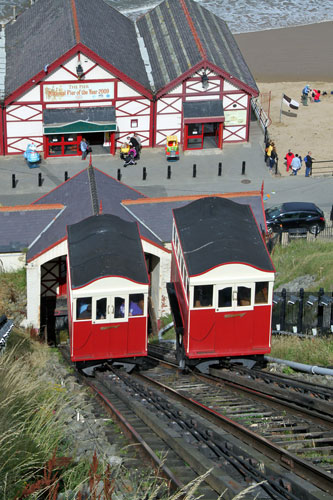
Saltburn Cliff Lift Publicity
Click images to open larger copies or
Download PDF
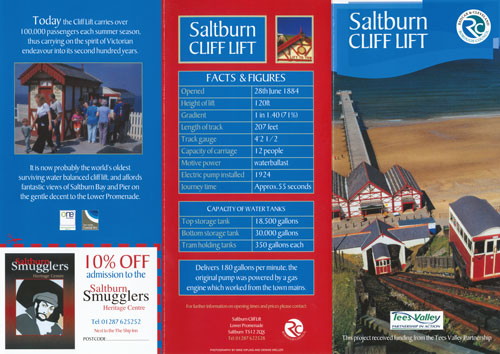
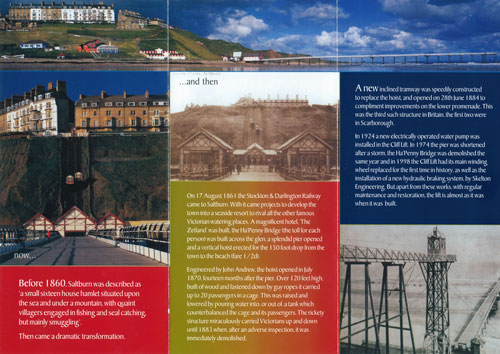
Saltburn Miniature
Railway
The Saltburn Miniature
Railway (SMR) is a 15inch gauge line opened in spring 1947, running
about half a mile from Cat Nab to the Valley Gardens, with stations at
each end. It was built by the Dunn family who also promoted railways at
Seaton Carew and Crimden Dene on the Durham Coast. Trains first ran at
Whitsuntide in 1947. The first locomotive No.7 was a petrol driven
steam-outline 2-4-0 of 1930 and it only ran for one season. The next loco was
a freelance 4-4-4T Elizabeth originally built by Bassett-Lowke
in 1909 for C.W.Bartholomew of Blakesley Hall. It was originally named
Blacolvesley and was powered by a12/14hp N.A.G petrol engine
coupled to a Wicksteed gearbox, making it probably the first of many
steam outline petrol/diesel locos to run on Britain's miniature
railways. At Saltburn Elizabeth was powered by an 8hp Austin
engine. A later addition, which remains on the railway, is the 4-6-2
steam outline streamliner Prince Charles built in 1953 by
Barlow of Southport for use on the railway there. It also served in
Belle Vue, Manchester. It ran as Prince of Wales at Saltburn
until 1976 before reverting to its original name.
At one time the railway was run by the local Saltburn Motor Services. It
is now enthusiast run by the Saltburn Miniature Railway Association, who
relaid the partially lifted track, and hopefully has a secure future.
Official website:
www.saltburn-miniature-railway.org.uk
Saltburn Miniature Railway with 4-4-4T petrol loco
Elizabeth
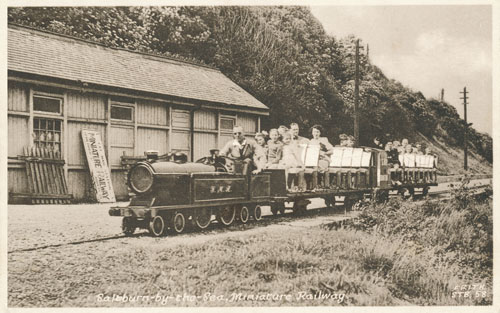
The Hornby No.2 O-Gauge 4-4-4T model released 1923
- based on the 1909 Bassett-Lowke original?
The closest full-sized prototype is the NER H1 4-4-4T
Image: ©2012
www.vectis.co.uk
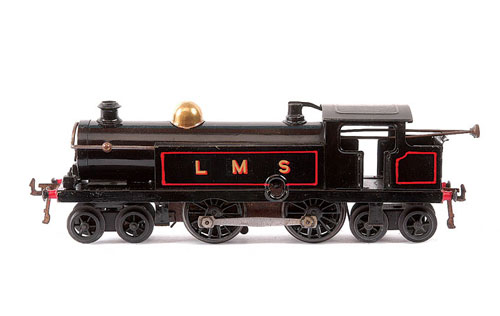
Saltburn Miniature Railway with 4-6-2
diesel-electric loco Prince Charles
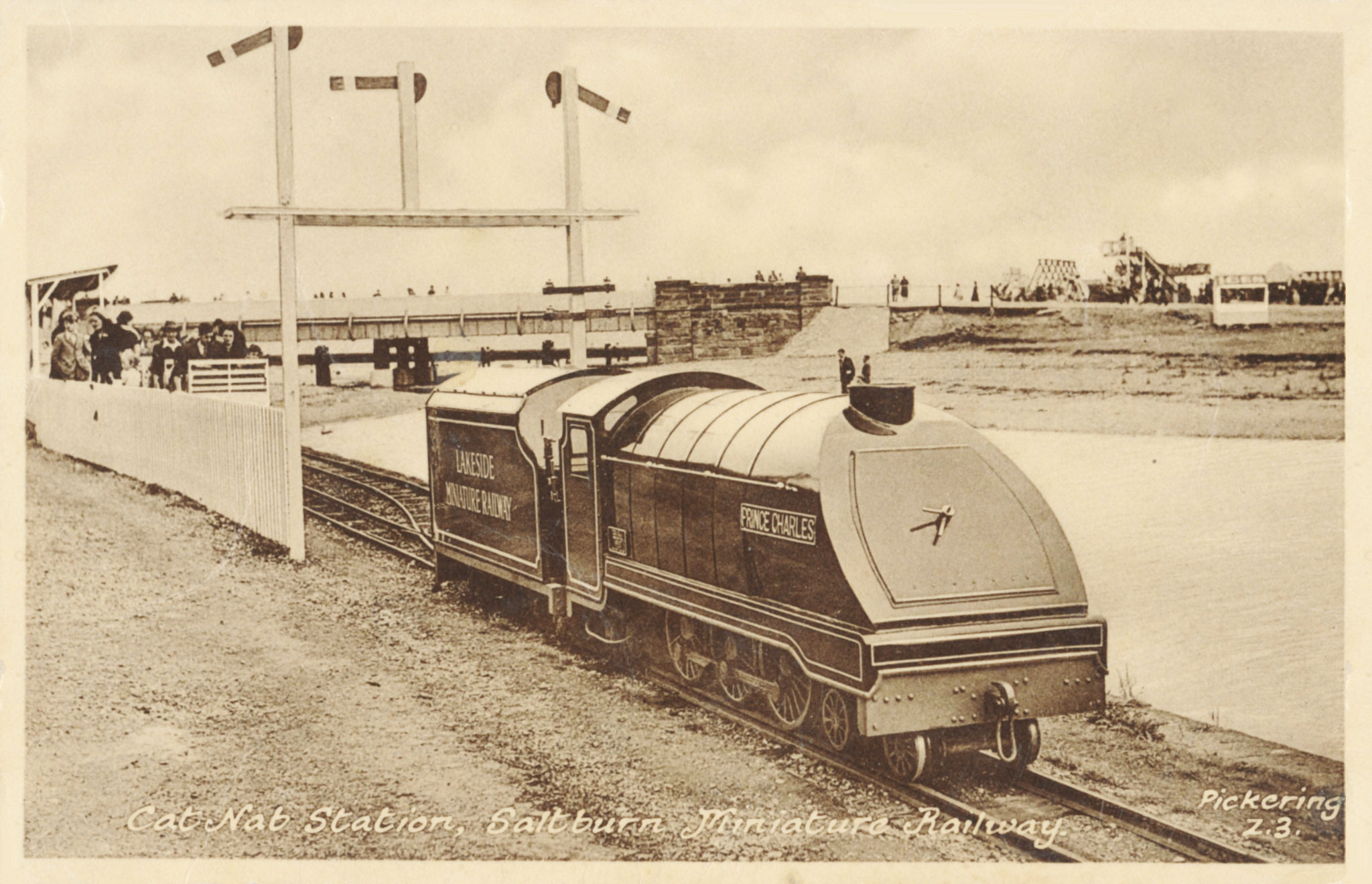
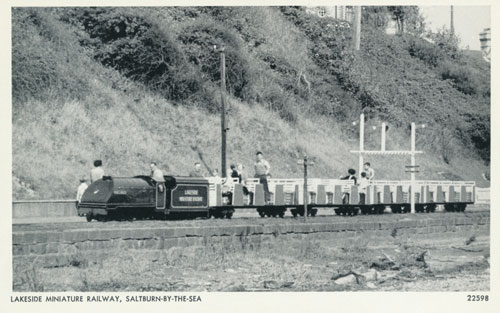
Postcard views of Saltburn showing the miniature
railway
